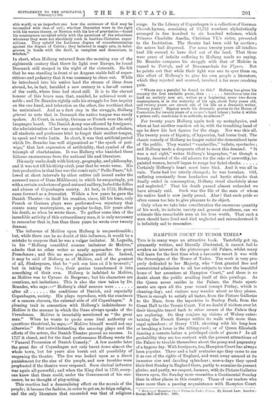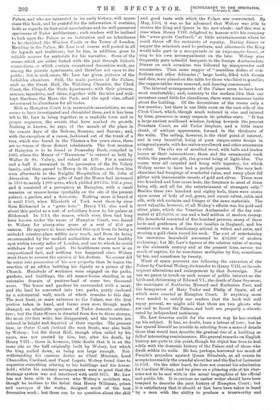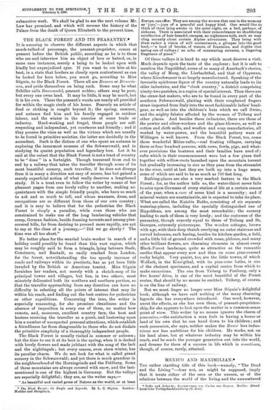HAMPTON COURT IN TUDOR TIMES.* Tins is in many ways
an attractive book. Tastefully got up, pleasantly written, and liberally illustrated, it cannot fail to awaken an interest in the picturesque old Palace, whilst many will learn for the first time what a favourite resort it was with the Sovereigns of the House of Tudor. The work is very pro- perly dedicated to her Majesty, who "first granted free and unrestricted admission to all her subjects to view the beautiful home of her ancestors at Hampton Court," and there is no doubt about the public availing itself of this privilege. As the Queen never resides in the Palace, the State apart- ments are open all the year round (except Friday, which is cleaning-day), and visitors may wander about as they please. There is enough to satisfy all tastes, from the Picture Galleries to the Maze, from the tapestries to Bushey Park, from the Great Hall to the Tennis Court. Yet we doubt if visitors ever let their thoughts travel back to other scenes of the Palace they are exploring. Do they conjure up visions of Wolsey enter- taining the French Envoys within its walls with more than regal splendour; of Henry VIII. shooting with his long-bow or breaking a lance in the tilting-yard ; or of Queen Elizabeth dancing a coranto before a privileged circle of guests P In all probability they are too content with the present attractions of the Palace to trouble themselves about the pomp and pageantry of a bygone day. With foreigners, too, Hampton Court has always been popular. Three and a half centuries ago they came to see it as one of the sights of England, and went away amazed at its immense size and dazzling splendour ; now-a-days they spend their first Sunday in England there, partly to examine its present glories, and partly, we suspect, because, with its Picture Galleries thrown open, the Sunday more resembles a Continental Sunday than in other places in this country. Those of our readers who have more than a passing acquaintance with Hampton Court
• History of Hampton Coo;-t Palate in Tudor Times. By Ernest Law. London, George B01 and Bone. 1885. Palace, and who are interested in its early history, will appre- ciate this book, and be grateful for the information it contains, both as regards its historical associations and its well-preserved specimens of Tudor architecture; such readers will be inclined to look upon the Palace as an institution and an inheritance to be cherished like Windsor Castle or the Tower of London. Residing in the Palace, Mr. Law is of course well posted in all its legends and traditions ; but he has, in addition, gone to reliable sources for materials for his narrative. Some of the rooms which are either linked with the past through historic connections, or which contain exceptional decorative work, are among the private apartments, and therefore not open to the public ; but in such cases, Mr. Law has given pictures of the forbidden chambers. Still, the main portions of the Palace, such as the Great Hall, the Watching Chamber, the Clock Court, the Chapel, the State Apartments. with their pictures, armour, tapestries, and china, together with the trim and well- kept Gardens, the Maze, the Park, and the aged vine, afford amusement in abundance for all tastes.
Rich as Hampton Court is in memorable associations, no one seems to have investigated and chronicled them, and it has been
left to Mr. Law to bring together, in a readable form and in
proper sequence, the events that have marked its growth.
Nothing is known, he says, of the annals of the place in the remote days of the Britons, Romans, and Saxons ; and, with the exception of a canoe, fashioned out of the trunk of a tree, which was found in the Thames a few years since, there are no traces of those distant inhabitants. The first mention of Hampton is to be found in Domesday Book, compiled in 1086, where the Manor of " Hamntone " is entered as held by Walter de St. Valery, and valued at £39. For a century and a half it remained in the possession of the De Valery family, and then passed to Henry de St. Albans, and from him soon afterwards to the Knights Hospitallers of St. John of Jerusalem. By various gifts of land the Manor had increased in 1333 to nearly 1,000 acres, which yielded £83 13s. 10d. a year, and it consisted of a preceptory at Hampton, with a small mansion or manor-house (probably on the site of the present palace), a garden, and a dove-cote. Nothing more is heard of it until 1503, when Elizabeth of York went there by river from Richmond in a " grete bote." Henry VII. also used it about this period as a sort of subsidiary house to his palace at Richmond. In 1514, the manor, which even then had long been known under the name of Hampton Court, was leased to Wolsey for ninety-nine years at a rent of £50 per annum. He appears to have selected this spot from its being a secluded country-place within easy retch, and from its being recommended by the medical authorities as the most healthy spot within twenty miles of London, and one to which he could withdraw for rest and quiet. Its healthiness even now is an unquestioned fact, and nothing has happened since Wolsey went there to reverse the opinion of his doctors. No sooner did he enter into possession of his new property than he began the erection of an edifice befitting his dignity as a prince of the Church. Hundreds of workmen were engaged on the parks, gardens, and buildings, the old manor-house standing in an extensive domain of pasture-land of some two thousand acres. The house and gardens he surrounded with a moat, and the land he converted into two parks, partly enclosed by a substantial wall, much of which remains to this day. The west front, or main entrance to t'se Palace, was the first portion taken in hand, and forms even now, though much changed, an admirable specimen of Tudor domestic architec- ture; but the Gate-House is dwarfed from five to three storeys, the moat (30 feet wide) has disappeared, and the turrets are reduced in height and deprived of their cupolas. The present base, or Outer Caart (behind the west front), was also built by Wolsey ; but the Great Hall, though often called by his name, was not erected by him, but, after his death, by Henry VIII.; there is, however, little doubt that it is on the same site as the hall originally built by Wolsey, but which the king pulled down, as being not large enough. Not- withstanding his onerous duties as Chief Minister, Lord Chancellor, Cardinal, and Papal Legate, Wolsey found time to supervise everything relating to his buildings and his house- hold ; whilst his sanitary arrangements were so good that the drainage system was not interfered with until 1871. Mr. Law has not been able to discover who Wolsey's architect was, though he inclines to the belief that Henry Williams, priest and, surveyor of the works, designed mach of the best decorative work ; but there can be no question about the skill and good taste with which the Palace was constructed. By May, 1516, it was so 'far advanced that Wolsey was able to receive the King and Queen in his new abode ; and this was a time when Henry VIII. delighted to honour with his company his " awne goode Cardinal]," at little entertainments where he could throw off the restraints of royalty. During dinner or supper the minstrels used to perform, and afterwards the King would take part in a masquerade or an impromptu dance, or
sing to his own accompaniment on the lute. Welsey also frequently gave splendid banquets to the foreign Ambassadors.
Dinner on such occasions was followed by masquerades and mummeries. Then came supper of "countless dishes of con- fections and other delicacies ;" large bowls, filled with ducats and dice, were placed on the table for those who liked to gamble; the supper-tables were removed, and dancing commenced.
The internal arrangements of the Palace seem to have been most comfortable ; and, contrary to the modern idea that our ancestors cared little for cleanliness, there were numerous baths about the building. Of the decorations of the rooms only a few survive ; but there is one little room on the east side of the Clock Court, which, though much reduced in size and injured by time, preserves in many respects its pristine state. "It has a large ancient mullioned window, looking towards the present
Fountain Court, an old Tudor fireplace, and a little inner closet, of antique appearance, formed in the thickness of the walls. The ceiling, however, is the chief point of interest, and is very beautiful, being of pure cinque-cento design in octagonal panels, with decorative scrollwork and other ornaments in relief. The ribs are of moulded wood, with balls and leaden leaves at their intersections ; these and the ornamental work within the panels are gilt, the ground being of light-blue. The rooms were all carpeted and hung with tapestry, for which Wolsey seems to have had a perfect passion. The very bed- chambers had hangings of wonderful value, and every place did glitter with innumerable vessels of gold and silver. There were two hundred and four-score beds, the furniture to most of them being silk, and all for the entertainment of strangers only." Besides these two hundred and eighty beds, there were scores upon scores of beds of red, green, and russet velvet, satin and silk, with rich curtains and fringes of the same materials. The most valuable, however, of all Wolsey's effects was his gold and silver plate, which the Venetian Ambassador of the day esti- mated at /1150,000, or one and a half million of modern money. His household consisted of five hundred persons, many of them lords and gentlemen of the first families in England; and his master-cook was a functionary attired in velvet and satin, and • wearing a gold chain round his neck. The cost of entertaining his enormous household amounted 'to £50,000 of modern reckoning; but Mr. Law's figures of the relative value of money in the sixteenth century and at the present time, savour too much of caprice, for he sometimes multiplies by five, sometimes by ten, and sometimes by twenty.
Want of space prevents our following the extension of the Palace by Cardinal Wolsey, its transfer to Henry VIII. or its sub- sequent alterations and enlargement by that Sovereign. Nor can we pause to touch on such scenes of public interest as the birth and christening of Edward VI., the death of Jane Seymour, the marriages of Katherine Howard and Katherine Parr, and the honeymoon of Mary Tudor and Philip of Spain, all of which were enacted at Hampton Court. If anything more were needed to satisfy our readers that the book will well repay perusal, we might add that there are two ghosts who are said to haunt the Palace, and both are properly a ithenti- cated by independent testimony.
Mr. Law deserves credit for the earnest way he has worked up his subject. It has, no doubt, been a labour of love ; but he has spared himself no trouble in selecting from a mass of details those that would best describe the gradual rise of a building so full of interesting reminiscences. His general remarks on English history are quite to the point, though his object has been to deal solely with the domestic history of the Palace and of those who dwelt within its walls. He has, perhaps, borrowed too much of Froude's prejudice against Queen Elizabeth, at all events he accepts too readily the scandal about her and the Earl of Leicester in 1561. On the other hand, he does not conceal his admiration for Cardinal Wolsey, and he gives us a pleasing side of his char- acter not to be met with in the usual biographies of his official and public life. It is curious no earlier writer should have been tempted to describe the past history of Hampton Court ; but it is satisfactory that it should at last have been taken in hand by a man with the ability to produce a trustworthy and exhaustive work. We shall be glad to see the next volume Mr. Law has promised, and which will resume the history of the Palace from the death of Queen Elizabeth to the present time.
















































 Previous page
Previous page